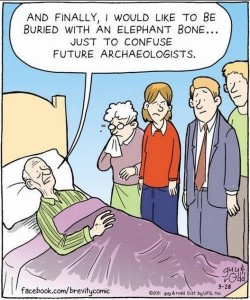Archeology is a discipline often shrouded in myth from popular culture. Characters such as Indiana Jones and Movies like The Mummy tend to lead people to associate archeology with the discovery and analysis of human remains. While human remains are undoubtedly interesting, there is a huge amount of information to be gleaned from animal bones discovered at archeological sites.
In fact, there is an entire discipline devoted to the study of these bones: Zooarchaeology. This include the study of bones, scales, shells, and even hair. Basically anything that at one point belonged to an animal. Bones and shells are the most studied, generally because they preserve the best in the archeological record. It is important to understand the differences between zooarchaeology and paleontology. Often thanks to popular culture the two different disciplines are easily confused. Both study animals of the past, however the difference lies in the fact that archeologists study animal remains as a function of their relationships to a human past. Paleontologists study bones as a function of their relationship to the history of life on earth as a whole, not just human.
Even without dinosaur bones, there is plenty of variety to be uncovered at archeological sites. The bones of animals are often recovered in large quantities. I saw this first hand during an archeology lab exercise this week, where my task was to assist in the reorganization of a variety of artifacts and ecofacts from a site in Annapolis, Maryland. Some of these items happened to be large bags consisting of a jumble of bone and fragments, that looked something like the below image.
Animal bones found at archeological sites could belong to domesticated herds, they could belong to pets, or wild animals hunted for food, or they could belong to pests such as rats and mice. So why does it matter. Why should we bother to separate out what type of animal each tiny piece of bone belonged to?
Studying animal bones provides knowledge about how people might have interacted with animals in the past. We have learned through bones such as these about what animal previous humans farmed, which they kept as pets and even which they chose to worship and/or sacrifice for religious purposes. Also from studying these bones archeologists can find indicators about the tools used in the past. Cut marks on the bone, can provide hints to the tools used to kill and butcher animals that did not die a natural death. The bones of small mammals such as rodents and birds, can even provide clues to the environment surrounding the exploratory site.
While there is no denying that the discovery of human skeletons tends to excite public interest, in many ways the tiniest rodent bone can provide just as much if not more information about the way those studied lived. Our relationship to animals and our manipulation of the environment has remained an important force throughout human history.
Works Cited:
Ashore, W.J., and Sharer, R.J., Discovering Our Past: A brief introduction to Archeology. 6th Edition.



A jumble of animal bones like the picture above is a zooarchaeologist’s dream! In the past few decades, the number of zooarchaeologists has been steadily on the rise in academic and collegiate circles. Since about the 1860s, zooarchaeology – or the study of faunal (animal) remains – was considered just one technique applied during archaeological study, but did not become a specialized discipline until around the 1950s. Zooarchaeology began really establishing itself in university and research settings in the 1970s, aided by the foundation of the International Council for Archaeozoology (ICAZ) in 1971. The council now has over 500 members from over 50 countries, according to their website (http://www.alexandriaarchive.org/icaz/index.htm)
When zooarchaeologists study animal bones, they can often tell if an animal was domesticated or wild, butchered for meat or used for a different purpose, and can even track the migratory patterns of different animals (which sometimes correlate to the migrations of the hunter-gatherers who depend on them). While zooarchaeology technically has to do with the study of animals in the archaeological record, the discipline gives unique insights into human behavior.